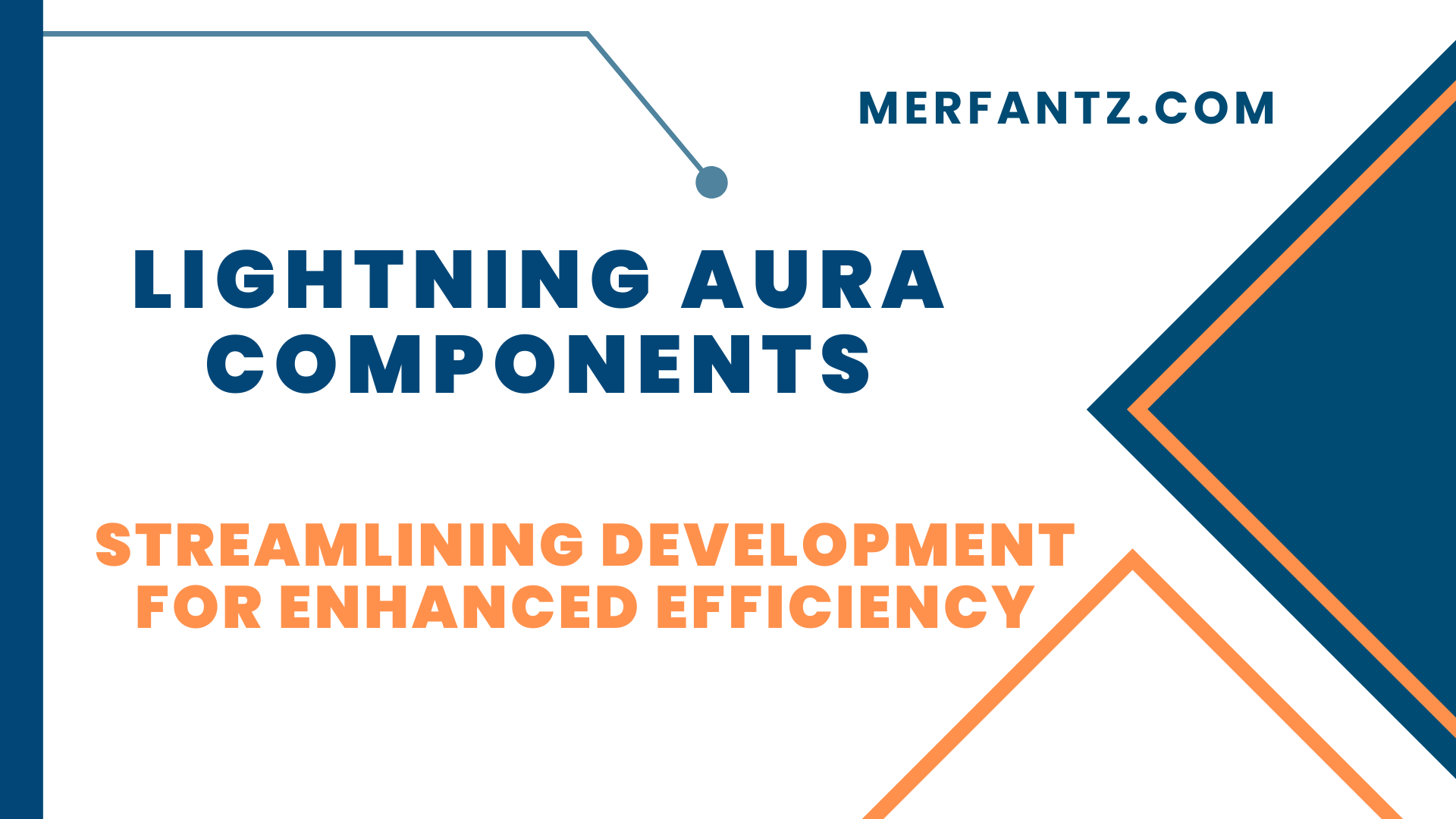Introduction to Lightning Aura Components
Lightning Aura Components are a vital part of Salesforce development, offering a powerful framework for building dynamic and interactive user interfaces. With Lightning Aura Components, developers can create lightning-fast, responsive applications that enhance user experience and productivity. These components are designed to work seamlessly with the Salesforce platform, enabling developers to leverage the full potential of Salesforce features and functionality.
At Merfantz Technologies, we understand the importance of Lightning Aura Components in modern Salesforce development. Our team of experienced developers excels in harnessing the capabilities of Lightning Aura Components to deliver cutting-edge solutions tailored to meet the unique business requirements of our clients. Whether it’s creating custom components or extending existing ones, our experts have the skills and expertise to streamline development and maximize the value of Lightning Aura Components.
Key Features and Benefits of Lightning Aura Components
Lightning Aura Components offer a wide range of features and benefits that empower developers to build robust and scalable applications. These components follow a component-based architecture, allowing for easy reuse and modularity. With Lightning Aura Components, developers can create reusable components, reducing development time and effort. Furthermore, Lightning Aura Components provide a responsive and intuitive user interface, enhancing the overall user experience.
Another key benefit of Lightning Aura Components is their seamless integration with the Salesforce platform. Developers can leverage Salesforce data and services effortlessly, making it easier to create applications that leverage the full potential of Salesforce. Additionally, Lightning Aura Components support event-driven programming, enabling communication between components and facilitating a cohesive application flow. These features combine to make Lightning Aura Components a powerful tool for Salesforce development.
Understanding the Architecture of Lightning Aura Components
To make the most of Lightning Aura Components, it’s essential to understand their architecture. Lightning Aura Components follow a hierarchical structure, with components nesting within each other to form a cohesive application. Each component consists of an XML markup file and a JavaScript controller, responsible for defining the component’s behavior and interactions. The architecture promotes code reusability, as components can be easily composed and combined to create complex and dynamic applications.
In addition to the hierarchical structure, Lightning Aura Components use a reactive programming model. This means that changes in the component’s attributes or state automatically trigger updates in the user interface, ensuring a seamless and responsive experience for users. The architecture of Lightning Aura Components provides developers with a flexible and scalable framework for building enterprise-grade applications that meet the demands of modern businesses.
Building Lightning Aura Components: Step-by-Step Guide
Building Lightning Aura Components requires a systematic approach to ensure efficient development. Here is a step-by-step guide to help you get started. Firstly, define the functionality and purpose of your component. Identify the attributes and events required for its functionality. Next, create the component’s XML markup file, specifying its structure and attributes. Then, develop the JavaScript controller to handle the component’s behavior and logic. Finally, test the component thoroughly to ensure its functionality and compatibility with other components.
During the development process, it is crucial to follow best practices and adhere to Salesforce development guidelines. This includes writing clean and modular code, optimizing performance, and incorporating error handling mechanisms. At Merfantz Technologies, our experienced developers have a deep understanding of Lightning Aura Components and can guide you through each step of the development process, ensuring the creation of high-quality components that align with your business objectives.
Best Practices for Lightning Aura Component Development
To ensure the successful development of Lightning Aura Components, it is essential to follow best practices. Firstly, maintain a modular approach by breaking down complex components into smaller, reusable ones. This promotes code reusability and makes maintenance and enhancements more manageable. Secondly, leverage the built-in security features of Lightning Aura Components to protect sensitive data and prevent unauthorized access. Additionally, optimize performance by minimizing server calls, utilizing caching mechanisms, and implementing efficient data retrieval strategies.
Another best practice is to thoroughly test your Lightning Aura Components. Conduct comprehensive unit tests to validate their functionality, including different scenarios and edge cases. Additionally, perform integration testing to ensure seamless interaction with other components and Salesforce features. Regularly review and refactor your code to enhance its readability, maintainability, and performance. By following these best practices, you can develop robust and reliable Lightning Aura Components that provide a superior user experience.
Enhancing User Experience with Lightning Aura Components
One of the significant advantages of Lightning Aura Components is their ability to enhance the user experience. These components offer a modern and intuitive user interface that is responsive and visually appealing. Through dynamic updates and real-time data rendering, Lightning Aura Components provide users with a seamless and interactive experience. Furthermore, by leveraging Lightning Design System (LDS) styling and components, developers can ensure consistency and adhere to Salesforce’s UI guidelines, resulting in a visually cohesive and professional application.
Personalization and customization are also key elements in enhancing the user experience with Lightning Aura Components. Developers can tailor the components to align with specific user preferences, allowing for a personalized and engaging interface. By incorporating features such as drag-and-drop functionality, inline editing, and interactive charts, developers can create highly interactive and user-friendly applications. At Merfantz Technologies, we specialize in designing and developing Lightning Aura Components that prioritize user experience, helping businesses drive user adoption and satisfaction.
Optimizing Performance in Lightning Aura Components
Optimizing performance is crucial when developing Lightning Aura Components to ensure a smooth and efficient user experience. One effective approach is to minimize server calls by implementing client-side caching mechanisms. By storing frequently accessed data locally, you can reduce the dependency on server requests, resulting in faster response times. Additionally, optimizing data retrieval by leveraging the Lightning Data Service (LDS) can further improve performance. LDS provides a streamlined approach to data manipulation and retrieval, reducing the complexity and overhead associated with traditional server calls.
Another performance optimization technique is to carefully manage the component’s lifecycle. Avoid unnecessary rerendering of components by leveraging the built-in lifecycle hooks, such as init(), render(), and rerender(). By selectively updating only the required parts of the component when data changes, you can minimize the impact on performance. Additionally, optimizing the component’s structure and leveraging lazy loading techniques for resources like images and scripts can significantly improve loading times. At Merfantz Technologies, we have expertise in performance optimization techniques for Lightning Aura Components, ensuring optimal user experience and application responsiveness.
Integration of Lightning Aura Components with Salesforce
Seamless integration with Salesforce is one of the key advantages of Lightning Aura Components. These components can leverage the vast array of Salesforce’s capabilities, including data management, workflow automation, and business logic. By utilizing Apex controllers and Aura-enabled methods, Lightning Aura Components can interact with the underlying Salesforce data and services, enabling developers to create powerful and cohesive applications. Furthermore, Lightning Aura Components can easily integrate with other Salesforce features such as Lightning Web Components, Visualforce pages, and external APIs, expanding the possibilities for application development and integration.
At Merfantz Technologies, we have extensive experience in integrating Lightning Aura Components with Salesforce. Our expert developers ensure smooth communication between Lightning Aura Components and various Salesforce elements, providing a seamless user experience and maximizing the value of Salesforce functionalities. Whether it’s retrieving and manipulating data, automating business processes, or integrating with third-party systems, our team has the expertise to deliver robust and efficient integrations that align with your specific business needs.
Advanced Techniques and Tips for Lightning Aura Components
Once you have mastered the fundamentals of Lightning Aura Components, exploring advanced techniques can elevate your development skills to the next level. One such technique is leveraging Lightning Data Service (LDS) to handle complex data operations and improve performance. By utilizing LDS, you can simplify data retrieval, manipulation, and caching, resulting in more efficient and scalable applications. Additionally, implementing advanced event-driven architectures, such as the Publish-Subscribe pattern, can facilitate seamless communication between components and enhance the overall flexibility and modularity of your application.
Furthermore, utilizing the Salesforce Lightning Design System (SLDS) to its full potential can enhance the visual appeal and consistency of your Lightning Aura Components. By following the SLDS guidelines, you can create visually appealing and accessible user interfaces that align with Salesforce’s design principles. Lastly, staying updated with the latest trends and advancements in Lightning Aura Components is essential to continuously improve your development skills. Attend webinars, join communities, and explore official Salesforce documentation to stay abreast of new features, best practices, and emerging techniques.
Stay Updated with the Latest Trends in Lightning Aura Components
In the rapidly evolving world of Salesforce development, staying updated with the latest trends in Lightning Aura Components is crucial to remain competitive and deliver cutting-edge solutions. One important trend is the increasing adoption of Lightning Web Components (LWC), the next generation of Salesforce’s component-based framework. As Lightning Web Components gain popularity, developers should familiarize themselves with this technology and explore the migration strategies from Lightning Aura Components to Lightning Web Components.
Furthermore, keeping an eye on the Salesforce roadmap and release notes is essential to stay informed about upcoming enhancements and new features related to Lightning Aura Components. Salesforce regularly introduces updates to improve performance, security, and usability, which can greatly impact the development and functionality of Lightning Aura Components. By staying updated, you can leverage new features and enhancements to enhance your applications and deliver exceptional user experiences.
FAQ:
Can Lightning Aura Components be used in both Classic and Lightning Experience?
Lightning Aura Components are primarily designed for use in the Lightning Experience interface. While they can be used in some areas of Classic, their full functionality and capabilities are best leveraged within the Lightning Experience.
Are Lightning Aura Components mobile-friendly?
Yes, Lightning Aura Components are mobile-friendly and can be used to create responsive applications that adapt to different screen sizes and devices. With the responsive design capabilities of Lightning Aura Components, you can deliver a consistent and optimized user experience across various devices.
What are the 3 types of Lightning components?
The 3 types of Lightning components are Aura components, Lightning Web Components, and Base Lightning Components.
What are the Aura components in Lightning?
Aura components are a type of Lightning component framework introduced by Salesforce. They follow a component-based architecture and use the Aura framework for development.
What are the components of Aura component?
Aura components consist of several elements, including the component markup file (XML), the controller (JavaScript), the helper (JavaScript), the renderer (JavaScript), the style (CSS), and any other necessary resources.
What is the difference between Aura component and Lightning component?
Aura components are a type of Lightning component, while Lightning component is a broader term that encompasses both Aura components and Lightning Web Components. Aura components use the Aura framework, while Lightning Web Components use the newer and more standards-based approach of web components.
Conclusion:
In conclusion, Lightning Aura Components are a powerful framework for Salesforce development, enabling developers to create dynamic and responsive applications. By leveraging their key features, following best practices, and optimizing performance, developers can streamline the development process and enhance the user experience. With seamless integration with Salesforce and the ability to stay updated with the latest trends, Lightning Aura Components empower businesses to leverage the full potential of the Salesforce platform. At Merfantz Technologies, we specialize in Lightning Aura Component development, providing tailored solutions that meet your unique business requirements and drive success in the Salesforce ecosystem.
Author Bio
Co-Founder & CMO at Merfantz Technologies Pvt Ltd | Marketing Manager for FieldAx Field Service Software | Salesforce All-Star Ranger and Community Contributor | Salesforce Content Creation for Knowledge Sharing






